Many components and structures are put together to make up a complete part. Using some essential tools can arrange these components. One of these heroes in the manufacturing industry is rivets. Different types of rivets are available for use based on their design requirements and properties.
These rivets offer incredible fastening capabilities for both light and heavy-duty applications. This makes them valuable for several applications, ranging from aircraft to submarines and sheet-metal assemblies. They are also beneficial for supporting tensile and shear loads.
This article will guide you through the various types of rivets and their uses. Let’s get right to it!
An Overview of Rivets
What is a Rivet?
In a nutshell, a rivet is a mechanical fastener or connector with a head and tail at opposite sides. It has a head, a smooth cylindrical body, and a tail that looks more like a metallic pin.
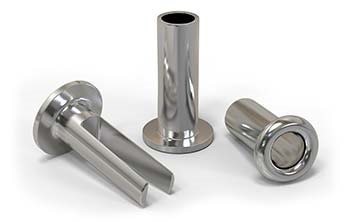
Rivets are usually made of aluminum or steel, but there are some made with other materials. These types of fasteners are not tightened like the usual bolt and nuts. Using unique installing methods with rivets helps to ensure permanent parts assembly or connection.
How Do Rivets Work?
Rivets are quite an essential tool in machine and structure construction. You can install rivets either through drilling, punching, or placing them in a hole and deforming the tail. The most popular riveting process includes drilling a hole in parts to be riveted. This is because it is much simpler and more accessible.
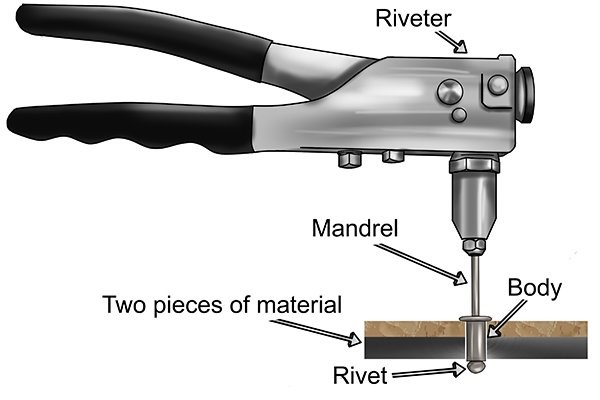
The rivet fits in a drilled hole that measures about 1.5 mm more than the rivet’s diameter itself to better secure the rivet. As soon as the rivet is installed, the tail comes out at the other end, where it is deformed. When you pound or smash the tail of the rivet, it flattens the material, which often makes the tail unfold or spread. It spread out to about one and a half times the original size.
In other words, you can create a dumbbell-sized rivet by pounding or pulling to break off the tail flatter on one end and create a new head on the other head. After that, the tail takes the shape of a dumbbell. This way, the joint has been riveted.
Disadvantages of Rivets
There is hardly a thing with its advantage without a downside or limitations. So, here are some of the disadvantages of riveting:
- Riveting is more time and labor-consuming than welding. It requires other additional work such as layouts and holes drilling.
- The labor cost of rivet joints is relatively high.
- Welded joints have lighter weights than rivet joints. This is because of the rivets and strap-plates in use.
- The riveting process results in more noise than when welding. The hammer blowing produces a loud noise.
- Riveting does not usually guarantee a tight and leak-proof joint.
- Joints put together using rivets are always heavier than those brazed or welded.
Materials Used for Rivets
There are several metal materials for manufacturing rivets. They include steel, copper, brass, aluminum, copper, and stainless steel. Designers and manufacturers choose these different materials to satisfy their needs.
With these vast materials, rivets now have unlimited applications. Therefore, it is advisable to select a rivet-making material that matches the properties of the parts you are about to join together.
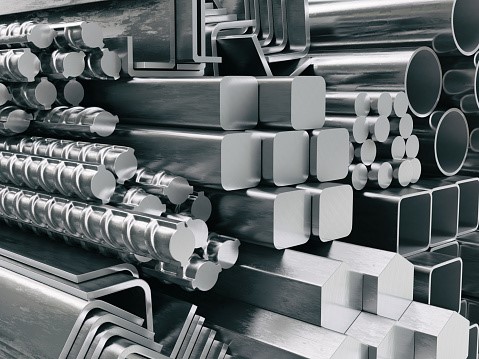
Steel
Steels with low carbon properties are suitable for rivets applications. This is due to its ability to clinch or fit well in its application. In addition, it is highly flexible and adaptive compared to rigid high carbon steel rivets. Rivets made with high carbon steels require more material while their moldability decreases.
Stainless Steel
The stainless steel rivets are considerably hard, strong, and withstand deterioration. These are the kind of rivets for locomotive, aircraft, and power-producing industries. These stainless rivets are employed for their ability to resist corrosion.
Aluminum
Aluminum is another metal variant with a renowned usage for rivets and fasteners. It is recognized for its tenderness and its lightweight attribute. Aluminum material offers a strong deterioration resistance, and it is suitable for several applications. Furthermore, aluminum is quite malleable; hence, it allows you to create complex part configurations easily.
Brass
Brass is a flexible, low-friction, and supple material. It has quite a fascinating resistance to tarnish and equally high strength. As a result of its properties, Brass cannot create sparks. These attributes render brass rivets the most suitable kind in gas appliances.
Copper
Copper is a flexible material, both in its appearance and applications. It has a remarkable ability to conduct heat and electricity. Copper material is a great conductor of electricity, making copper rivets most preferred in water and electrical appliances.
Different Types of Rivets Available for Manufacturing
There are several different types of rivets available. However, they are broadly divided into the following categories.
Solid Rivets: The Most Common Rivets
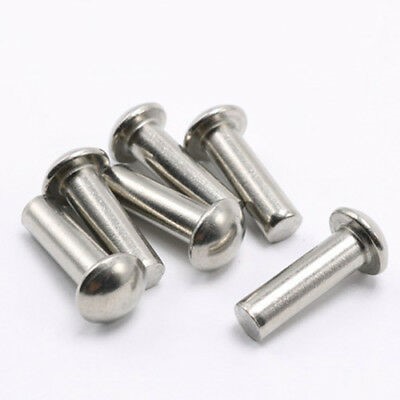
These rivets are the most common types of rivets. They are straightforward, dependable, and the oldest forms of joining materials. These simple tools consist of a solid shaft with a head on a particular side once it is punched in. The headless part on the other end gets deformed using a rivet gun or hammer.
Solid rivets consist of only shafts and heads, which are deformed using a rivet gun or hammer. These types of rivets can come with either 100 degrees countersunk or round universal heads. Solid rivets are often utilized in cases where safety and reliability are critical. For example, one of the typical applications is in the structural parts of aircraft.
Blind Rivets: Also Named Pop Rivets
Blind rivets are otherwise referred to as hollow or pop rivets. These metal rivets are tubular fasteners with a mandrel through their center. Manufacturers insert blind rivets into drilled holes made in parts intended for joining.
The blind end of the rivets expands, causing the mandrel to snap off. Unlike with solid rivets, you can install blind rivets in joints from one side of the part. This way, they are “blind” to the other side. Blind rivets are suitable in situations where it is difficult to see the rear end of a joint. Like any other rivets, it is pretty easy and fast to apply. It is the most dominant joint in aerospace, electronics, and shipbuilding.
Some of the common blind rivets available for use are:
- Pull-Mandrel Rivets – are special double countersunk blind rivets providing flush surface clinches on both sides of their applications. Here, the mandrel head doesn’t break away, providing consistent clamp force. In addition, the tight radial set in these rivets increases structural rigidity.
- Threaded Rivets – also known as blind rivet nuts or threaded inserts. Manufacturers can anchor this variant of standard blind rivets from one side of the installed part. There are standard and heavy-duty threaded rivets. Standard options satisfy almost every blind application for permanent installation. However, heavy-duty rivets feature heavy-duty sidewalls and heads. Thus, they are helpful for high-performance and more demanding applications.
- Drive-Pin Rivets – these types of blind rivets have short mandrels protruding from their heads. Once you insert a drive-pin rivet into a hole, its mandrel can work using a hammer or other material. This flares out the rivet’s end that is inside the hole. Drive-pin rivets are more popular for architectural and other aesthetically-intended applications because they do not require the drilling of holes. However, you must note that they have lesser clamping force than many other types of rivets.
Tubular Rivets: With a Hollow End
They are partially hollow rivets with many different configurations. The generic tubular rivet comes with a manufactured head on one side and a hollow end on the other side. The hollow end sticks through every piece for joining. Manufacturers often cold-form the hollow end to a field head.
Since there is a need for extensive cold forming for these rivets, it is essential that they are very ductile and are of low-strength metals. As a result, tubular rivets are popular in commercial applications. Some of the specific tubular rivets types are:
- Compression Tubular Rivets – these rivets consist of two parts with an interference fit during the fastening process. Their commercial use is in soft materials and needs aesthetics on both sides of the component.
- Full Tubular Rivets – they have deeper holes than their counterparts. They are also usually weaker than semi-tubular rivets. However, they can easily pierce softer materials like fabric and plastic.
- Semi-Tubular Rivets – these types of rivets have their holes in the field end. The hole depth is usually about 1.12 of the shank diameter. Thus, the semi-tubular rivet may feel like a solid rivet upon forming the field head.
Split Rivets: Home Repair Rivets
Also referred to as bifurcated rivets, split rivets are closely related to self-piercing rivets. They are the best options for joining softer materials like leather, plastic, and wood.
Split rivets are available with split or sawed bodies and are applicable to home repairs. Also, they have sharp ends or tips that allow them to make holes in the materials themselves. It is not advisable to use them in extreme or critical applications.
Flush Rivets: Also Called Countersink Rivets
Flush rivets, also countersunk rivets are used on external surfaces to ensure a good appearance and eliminate aerodynamic drag.
This is due to its use of both countersunk holes and heads. For reduction of drag and turbulence (aerodynamic reasons), flush rivets are functional on aircraft exterior. There may be a need for more post-installation operations to improve airflow.
Self-Piercing Rivets: Great Column Strength
This category of rivets does not call for the need to drill or punch holes before use. This is because the end of these rivets possesses a bevel drill or chamfered poke to pierce the components involved. Self-piercing rivets pass through the top layer of the material while leaving the bottom layer half pierced, forming a gas-tight or water joint. An upsetting die causes the tail of the rivet to flare and interlock into the bottom sheet to form a low-profile button.
Friction Lock Rivets: Similar to Expanding Bolts
They are made in a cupola or countersunk way. These friction-lock rivets are similar to expanding bolts.
The difference is that their shafts snap below the surfaces whenever there is a high enough tension. A friction lock rivet is an original form of blind rivets, commonly applied in the aerospace field for light aircraft repairs.
If you need CNC machining metal rivets, RapidDirect is your best partner.
What are Rivets Used For?
Rivet’s primary purpose is to ensure a firm and reliable tightening of two or more metallic or wooden materials. When you do this, you have a joint stronger than that of a screw with the same diameter.
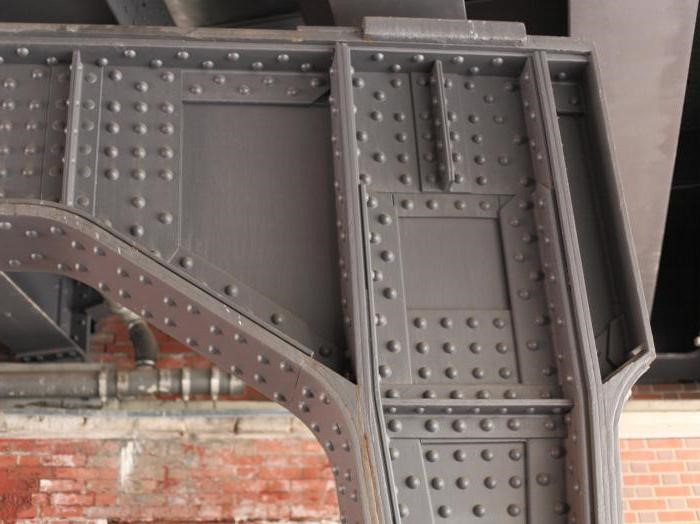
Here are some of the uses of rivets:
Rivets in Aircrafts
Originally, aircraft machining projects should be made of solid, durable, and dependable materials. Unfortunately, everything might fall apart if operators don’t tighten these solid and heavy materials together well. Therefore, riveting is essential to aircraft construction as much as brazing, welding, and bolting.
The main aim is to have a strong alignment, and the strongest combination of parts joined together, and riveting is important to achieve this. Rivets help to fasten aluminum alloys together due to their difficulty to solder. Riveting also ensures neatness and strength, creating room for lighter weight in aircraft. In cases of aircraft repair or construction, reaching the far end of a tightened structure may prove difficult or nearly impossible. Riveting is the only remedy in this situation.
Jewelry
Professional and amateur jewelry manufacturers include riveting as a cold joining technique in their operations. Jewelry producers can easily employ riveting to achieve cold connections by using some instructional videos, basic metal forming skills, and some common tools. Riveting has made it quite possible for fabricators to connect metallic pieces in jewelry without necessarily soldering.
Joints
Rivet is famous for its efficiency when it comes to construction. It is a sophisticated connector that allows you to connect different parts of a machine and structure easily. This rivet facilitates the joining of cabinets, wooden shelves, lockers. Using rivets as joints can connect any wooden materials.
Rivets serve as a joint that is considerably durable and reliable than screws and lines. For instance, when rivets are used as joints in furniture, such furniture is bound to last longer. This is due to the rivets keeping the furniture in place over time.
Home Building
Perchance you take a good look at what you have in your home, in and out of it. You are likely to come across one or two rivets that you haven’t seen before now. The fact is, they are likely to be present in your immediate environment. These rivets are applicable to fiberglass roofing. So, if your house has this kind of roofing, rivets help to hold the glass together.
Also, rivets are effective materials in the construction of gutters. They are more dependable than nails for fastening metal sheets together. More importantly, riveting helps make structures like window blinds, wind guards, doors, and even hanger straps.
Conclusion
Rivets are a better substitute for screws, bolts, and nuts. They prove more efficient and reliable than all other connectors. Today, different types of rivets have various purposes. This is a result of the dynamic nature of machines and structures. However, you have to choose suitable metal rivets for your applications to get the best results.
RapidDirect provides essential CNC machining metal rivets. We also deliver the best custom precision CNC machining services for prototyping and production machining. Our expert technicians have the right experience to provide the best services for desired results with fast lead times.
Once you upload your design file, our system carries out automated DfM analysis and delivers an instant quote to you. Whenever you need the best metal rivets for CNC machining, contact RapidDirect.
FAQs
In mechanical applications, there are permanent joints and non-permanent joints. An example of permanent joints is the rivet. Rivets use mechanical force on parts to join the parts together permanently. The process of joining these parts together is riveting.
Stainless steel rivets combined with either stainless steel or steel mandrels are the strongest. However, steel rivets combined with steel mandrels are also solid. This is also the case with aluminum rivets combined with steel mandrels.
There are several types of rivets available for your applications. However, solid, blind, tubular, split, flush, self-piercing, and friction lock rivets are the most common ones.


